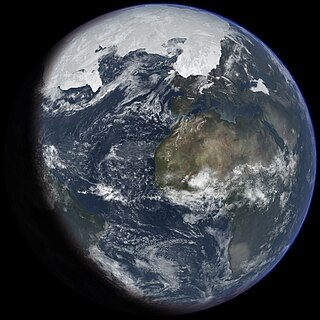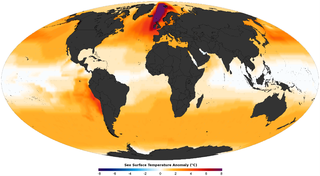
An ice age is a long period of reduction in the temperature of Earth's surface and atmosphere, resulting in the presence or expansion of continental and polar ice sheets and alpine glaciers. Earth's climate alternates between ice ages and greenhouse periods, during which there are no glaciers on the planet. Earth is currently in the Quaternary glaciation. Individual pulses of cold climate within an ice age are termed glacial periods, and intermittent warm periods within an ice age are called interglacials or interstadials.
The Pliocene is the epoch in the geologic time scale that extends from 5.333 million to 2.58 million years BP. It is the second and most recent epoch of the Neogene Period in the Cenozoic Era. The Pliocene follows the Miocene Epoch and is followed by the Pleistocene Epoch. Prior to the 2009 revision of the geologic time scale, which placed the four most recent major glaciations entirely within the Pleistocene, the Pliocene also included the Gelasian Stage, which lasted from 2.588 to 1.806 million years ago, and is now included in the Pleistocene.

The Quaternary is the current and most recent of the three periods of the Cenozoic Era in the geologic time scale of the International Commission on Stratigraphy (ICS). It follows the Neogene Period and spans from 2.588 ± 0.005 million years ago to the present. The Quaternary Period is divided into two epochs: the Pleistocene and the Holocene.
The Snowball Earth hypothesis proposes that, during one or more of Earth's icehouse climates, the planet's surface became entirely or nearly entirely frozen. It is believed that this occurred sometime before 650 M.Y.A. during the Cryogenian period. Proponents of the hypothesis argue that it best explains sedimentary deposits that are generally believed to be of glacial origin at tropical palaeolatitudes and other enigmatic features in the geological record. Opponents of the hypothesis contest the implications of the geological evidence for global glaciation and the geophysical feasibility of an ice- or slush-covered ocean, and they emphasize the difficulty of escaping an all-frozen condition. A number of unanswered questions remain, including whether Earth was a full snowball or a "slushball" with a thin equatorial band of open water.

Climate variability includes all the variations in the climate that last longer than individual weather events, whereas the term climate change only refers to those variations that persist for a longer period of time, typically decades or more. In addition to the general meaning in which "climate change" may refer to any time in Earth's history, the term is commonly used to describe the current climate change now underway. In the time since the Industrial Revolution, the climate has increasingly been affected by human activities that are causing global warming and climate change.
Paleoclimatology is the study of climates for which direct measurements were not taken. As instrumental records only span a tiny part of Earth's history, the reconstruction of ancient climate is important to understand natural variation and the evolution of the current climate.
The Anthropocene is a proposed geological epoch dating from the commencement of significant human impact on Earth's geology and ecosystems, including, but not limited to, anthropogenic climate change.

There have been five or six major ice ages in the history of Earth over the past 3 billion years. The Late Cenozoic Ice Age began 34 million years ago, its latest phase being the Quaternary glaciation, in progress since 2.58 million years ago.
The geologic temperature record are changes in Earth's environment as determined from geologic evidence on multi-million to billion (109) year time scales. The study of past temperatures provides an important paleoenvironmental insight because it is a component of the climate and oceanography of the time.
The Flandrian interglacial or stage is the name given by geologists and archaeologists in the British Isles to the first, and so far only, stage of the Holocene epoch, covering the period from around 12,000 years ago, at the end of the last glacial period to the present day. As such, it is in practice identical in span to the Holocene.

Marine isotope stages (MIS), marine oxygen-isotope stages, or oxygen isotope stages (OIS), are alternating warm and cool periods in the Earth's paleoclimate, deduced from oxygen isotope data reflecting changes in temperature derived from data from deep sea core samples. Working backwards from the present, which is MIS 1 in the scale, stages with even numbers have high levels of oxygen-18 and represent cold glacial periods, while the odd-numbered stages are lows in the oxygen-18 figures, representing warm interglacial intervals. The data are derived from pollen and foraminifera (plankton) remains in drilled marine sediment cores, sapropels, and other data that reflect historic climate; these are called proxies.

The Quaternary glaciation, also known as the Pleistocene glaciation, is an alternating series of glacial and interglacial periods during the Quaternary period that began 2.58 Ma and is ongoing. Although geologists describe the entire time period up to the present as an "ice age", in popular culture the term "ice age" is usually associated with just the most recent glacial period during the Pleistocene or the Pleistocene epoch in general. Since planet Earth still has ice sheets, geologists consider the Quaternary glaciation to be ongoing, with the Earth now experiencing an interglacial period.
Plows, Plagues and Petroleum: How Humans Took Control of Climate is a 2005 book published by Princeton University Press and written by William Ruddiman, a paleoclimatologist and Professor Emeritus at the University of Virginia. He has authored and co-authored several books and academic papers on the subject of climate change. Scientists often refer to this period as the “Anthropocene” and define it as the era in which humans first began to alter the earth's climate and ecosystems. Ruddiman contends that human induced climate change began as a result of the advent of agriculture thousands of years ago and resulted in warmer temperatures that could have possibly averted another ice age; this is the early anthropocene hypothesis.
The Early Anthropocene Hypothesis is a stance concerning the beginning of the Anthropocene first proposed by William Ruddiman in 2003. It posits that the Anthropocene, a proposed geological epoch coinciding with the most recent period in Earth's history when the activities of the human race first began to have a significant global impact on Earth's climate and ecosystems, did not begin during European colonization of the Americas, as numerous scholars posit, nor the eighteenth century with advent of coal-burning factories and power plants of the industrial era, as originally argued by Paul Crutzen, nor in the 1950s as claimed by the Anthropocene Working Group, but dates back to 8,000 years ago, triggered by intense farming activities after agriculture became widespread. It was at that time that atmospheric greenhouse gas concentrations stopped following the periodic pattern of rises and falls that had accurately characterized their past long-term behavior, a pattern that is explained by natural variations in Earth's orbit known as Milankovitch cycles.
Throughout Earth's climate history (Paleoclimate) its climate has fluctuated between two primary states: greenhouse and icehouse Earth. Both climate states last for millions of years and should not be confused with glacial and interglacial periods, which occur as alternate phases within an icehouse period and tend to last less than 1 million years. There are five known Icehouse periods in Earth's climate history, which are known as the Huronian, Cryogenian, Andean-Saharan, Late Paleozoic, and Late Cenozoic glaciations. The main factors involved in changes of the paleoclimate are believed to be the concentration of atmospheric carbon dioxide, changes in Earth's orbit, long-term changes in the solar constant, and oceanic and orogenic changes from tectonic plate dynamics. Greenhouse and icehouse periods have played key roles in the evolution of life on Earth by directly and indirectly forcing biotic adaptation and turnover at various spatial scales across time.

The carbonate–silicate geochemical cycle, also known as the inorganic carbon cycle, describes the long-term transformation of silicate rocks to carbonate rocks by weathering and sedimentation, and the transformation of carbonate rocks back into silicate rocks by metamorphism and volcanism. Carbon dioxide is removed from the atmosphere during burial of weathered minerals and returned to the atmosphere through volcanism. On million-year time scales, the carbonate-silicate cycle is a key factor in controlling Earth's climate because it regulates carbon dioxide levels and therefore global temperature.

During the Pliocene epoch, climate became cooler and drier following the Miocene, and seasonal, similar to modern climates.

Maureen E. "Mo" Raymo is an American paleoclimatologist and marine geologist. She is the Co-Founding Dean of the Columbia Climate School, Director of the Lamont–Doherty Earth Observatory of Columbia University, the G. Unger Vetlesen Professor of Earth & Environmental Sciences, and Director of the Lamont–Doherty Core Repository at the Lamont–Doherty Earth Observatory of Columbia University. She is the first female climate scientist and first female scientist to head the institution.
John E. Kutzbach was a climate scientist who pioneered the use of climate models to investigate the causes and effects of large changes of climate of the past.

The Late Cenozoic Ice Age, or Antarctic Glaciation began 33.9 million years ago at the Eocene-Oligocene Boundary and is ongoing. It is Earth's current ice age or icehouse period. Its beginning is marked by the formation of the Antarctic ice sheets. The Late Cenozoic Ice Age gets its name due to the fact that it covers roughly the last half of Cenozoic era so far.










